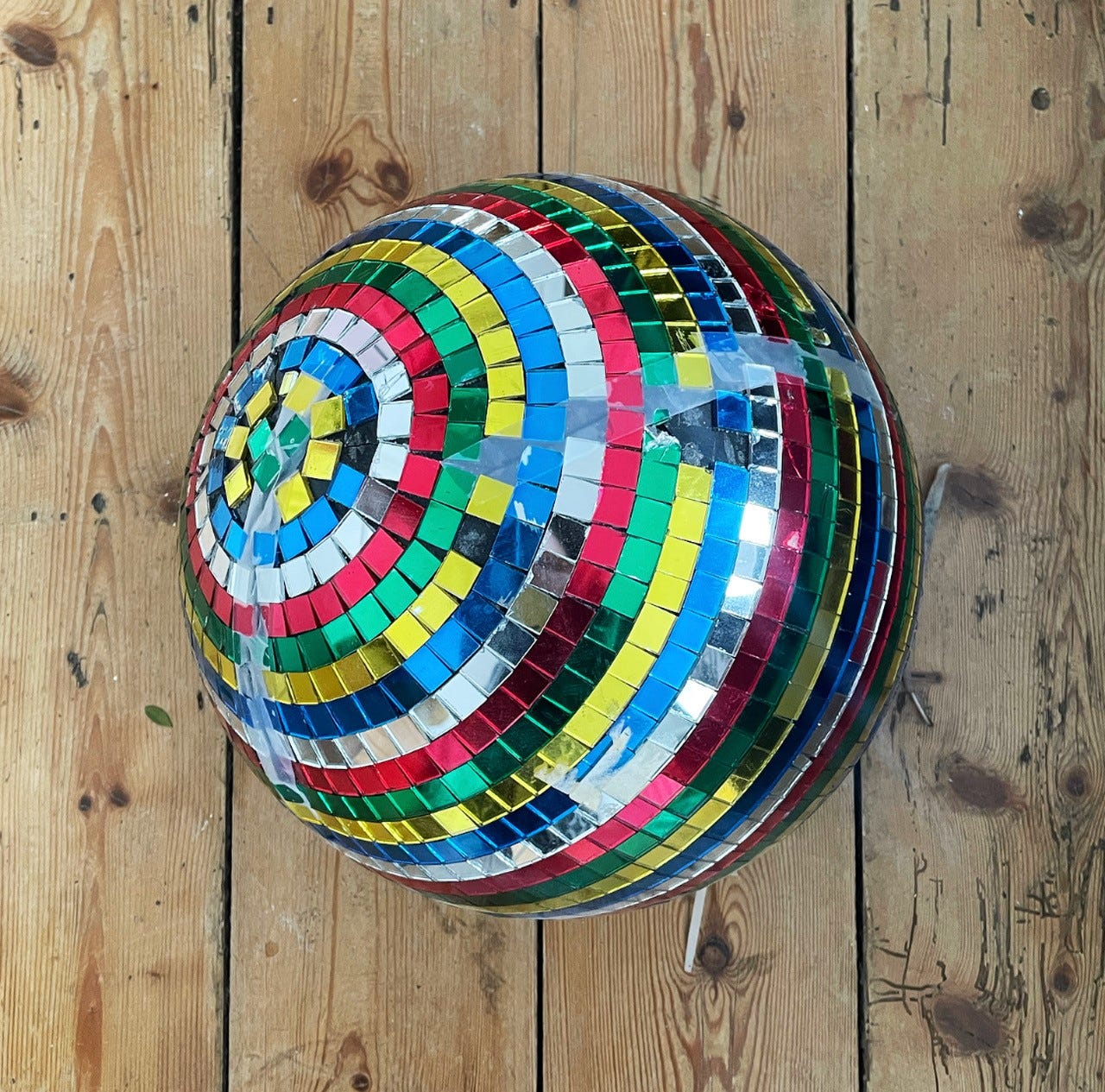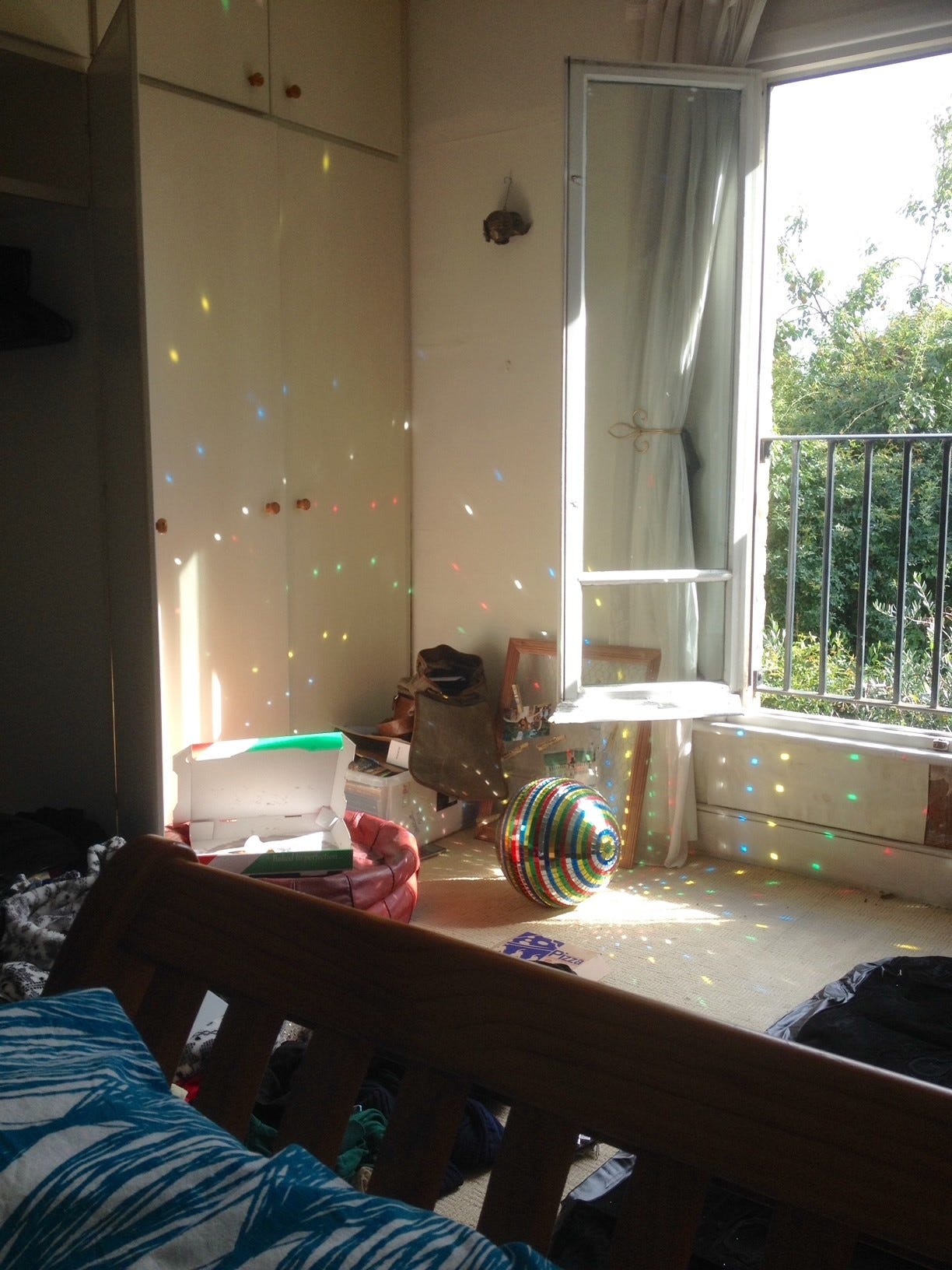It was a raucous party in a bygone age. A time when bodies, slick with sweat and glitter, writhed together on a makeshift dance floor; where the cigarette smoke of strangers still met and mingled, exhaled with inebriated words exclaimed, before twisting away into the early morning air. It was the sort of party where illegal substances and illicit liaisons ran rife in the relative quiet of upstairs rooms; where the undulating sound of bass thumped through walls and ran invisible hands across the ceiling. I couldn’t have known it, couldn’t have foreseen it; these fingers, fretting silently at my haphazard knots, which bound a gently twisting disco ball to the room’s light fixture. When at last the string could no longer hold the sphere crashed to the floor, where it roamed and rolled amongst the unheeding dancers, eventually coming to rest with a great crack in its frame.
“It’s just an object” is a statement often observed, a well-intentioned reminder that “things” don’t really matter. We humans are sentimental about the items we acquire, attributing meaning and emotion to our accumulations; conversely, we are told that objects are of little consequence and our affections for them are rendered trivial in the process. In a modern society our items are presented as replaceable, immaterial amidst the corporeal matters of life, love and loss, and fleeting in the face of mass production. But if you’re reading this newsletter you likely know as well as I do: the objects we surround ourselves with do matter. This is the story of something that had mattered to me.
Down sloping streets of stones well-trod, I’d come across the disco ball several years before. In a little music shop in the centre of York, a city steeped in rich history of its own and mine, it hung lazily from the ceiling like a secret. I’ve owned a great many disco balls in my time and coveted many more — but this was not just any disco ball. With a mighty 40 inch circumference, here was an object that had lived, really lived; a rainbow riot of reflective glass, casting kaleidoscopes of colour across everything beneath it.
I asked the nonplussed seller behind the counter if the disco ball was for sale, upon which he peered up with the air of a man who had, until that very moment, forgotten the twisting world of colour above our heads had existed at all. It had been there so long, he said, that he didn’t know if it was for sale or indeed where it had appeared from. He gamely fetched a rickety stepladder and, brandishing an old toothbrush, gently worried away the dust and grime that had settled upon its surface. 10 minutes later, £20 lighter, I stepped out into the world, arms clasped around an object that seemed to me to encapsulate that very time of life; a tumult of sparkle and uncertainty, where I teetered on the precipice of adulthood, buoyed by the joy of first love and new beginnings.
That’s the thing, of course, about joy, and love, and life. Amongst the gamut of all human emotions they’re the states of being we most aspire to, magical moments made all the more profound and desirable by the realisation of their transience. Like so many objects, the disco ball would outlive that particular love, and as it turned out it mattered all the more for it. Instead I stepped onwards into new worlds, unanticipated terrain experienced in sharp, glittering focus. My arms stayed clasped around this object, which had come since to symbolise my sense of self as it was at that time: a little buried, a little bruised, but nevertheless, persevering. I strung the disco ball up in a new place with new people and it became an anchor; a marker and a milestone, straddling past and present. Where fault lines had opened up elsewhere in life, the disco ball meant stability, longevity. It meant I had stayed intact.
But objects live lives of their own, and on that fateful night in 2015 the disco ball had other ideas. From above our heads it came crashing down, splitting along its top and shedding shattered pieces across the sticky floor. My fellow dancers were bemused; I, bereft at the breakage and the loss that went with it. There was a fissure, now, between worlds, a crack that suggested an incorrigible truth: that something that had mattered was now beyond all repair. I was overcome with the desire to fix my disco ball (no easy feat) and overwhelmed with knowing how to begin.
I’ve always held great affection for my things, but during lockdown our collective relationship with objects has undergone a most profound transformation. As the days became months and reality hit, we battened down the hatches and took stock of what was important in our lives, finding comfort in the items that we surround ourselves with whilst pondering the worlds we wanted to emerge into at “the end”. Our things have never mattered more: we’ve sent gifts and thoughts into the air; we’ve increasingly eschewed fast fashion, opting instead to mend our beloved garments; we’ve crafted and created and reimagined in ways we never thought possible. Amidst the wreckage of our collective grief, we’ve dared to envisage a future, a place beyond the ruins that just might be all the brighter for this darkness.
The ancient Japanese practice of kintsugi feels particularly apt at present. A slow-paced and precise means of physically mending pottery using lacquer mixed with gold, kintsugi is also a philosophy: an acknowledgement of brokenness and a visceral celebration of the beauty to be found in putting the pieces back together again. Meaning “golden joinery”, the method treats breakage and repair as part and parcel of the object’s life, accepting the inevitability of change by literally illuminating its imperfections.
When my fault lines opened up, it took time to see that better things would soon come along to repair them; that they’re now more golden than I could have conceived. And the disco ball? After a period of mourning for those last, little ruptures, I drew myself up and I mended the object as best I could; because it mattered, because it meant something. Now, it maintains pride of place despite its obvious scars, catching the last rays of the evening sun and casting them across the space it inhabits with every bit as much gusto and integrity as before.
Long before our chance encounter in a little shop in York, the disco ball had observed bodies dancing and cigarette smoke twisting and people loving — before I had wanted to fix its faults, before I realised that not everything can or need be fixed. I thought it had mattered because it embodied a moment, a secret, a dream of something that had seemed possible, once upon a time. But give them half a chance and those objects will embody so much more: all the loves and the losses and the golden fault lines of a life, lived well, that mattered.
Thank you for joining me for this first newsletter. I know we’re all a little bruised and a little broken, especially right now. But as the late, great Leonard Cohen said best:
There is a crack, a crack in everything
That’s how the light gets in.



